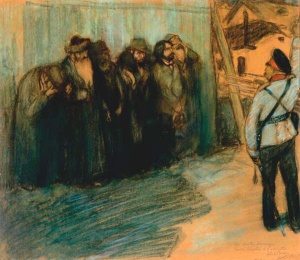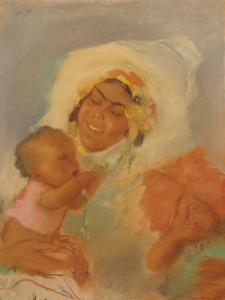Abel Pann at the Mayanot Gallery
We live apart, us Jews. Partially by God’s command, partially because of age-old enmity from non-Jews. It is even said by some that the hatred fostered by our neighbors strengthens us to keep our laws and traditions, helps us resist assimilation. But what is the essential nature of “the other?” How can we sum up the fundamental difference between the Jewish people and “the Nations.” Is this an irreversible family conflict?
Of course, it all began with Isaac’s family as Rebecca gave birth to fraternal twins, Jacob and Esau. In her womb they struggled mightily and finally in birth their fundamental differences became obvious. One was ruddy and covered with hair, one was smooth and their differences were never just skin deep. They never got along. The great Israeli artist, Abel Pann, reveals the depths and consequences of that struggle in two pastels currently on view at the Mayanot Gallery in Jerusalem.
Abel Pann (1883-1963) was an early and influential teacher at the Bezalel Academy in Jerusalem and from 1906 spent ten intensive years working in Paris as an artist, cartoonist and pictorial journalist. He was a student of the French Academy master Adolphe Bouguereau and, earlier, Yehuda Penn, the teacher of Chagall. As an artist he frequently found himself in the right place at the right time. And he made the most of it. He easily soaked up the color and radical ideas of the Post-Impressionists, absorbed a keen sense of observation from the academy along with a fluidity and inventive line instilled by Penn that would serve him well throughout his long career.
After a few years in Palestine from 1913-1914 teaching at the Bezalel School, Pann returned for good in 1920 and quickly settled on the project that would occupy him the rest of his life; the illustration of the Torah. This series of Biblical paintings, pastels and lithographs, along with projects depicting the persecutions of Jews during the Russian Pogroms, First World War and finally the Holocaust assured him a place of honor among the greatest of Jewish artists.
As the son of a Rosh Yeshiva Abel Pann felt uniquely suited bring together a love of Torah, the Land of Israel and a particularly Jewish artistic vision in his illustrations of the Torah. It cannot be underestimated the courage and conviction it took to claim this subject matter as his own in the face of almost total rejection by the contemporary art establishment.
His determination to depict the personalities of the Torah in native Palestinian dress, with a particular emphasis on Yemenite, Bedouin and Arab costume was an outgrowth of his belief that these “native” peoples where somehow the modern equivalents of the ancient Jews. It seemed sensible that if this was how the contemporary indigenous inhabitants of the Middle East dressed, so too our forefathers must have appeared. Perhaps more fundamentally, it was believed by Pann and many other early immigrants that these “natives” had, by virtue of their assumed long term presence, a more legitimate link to the land and its history than the newly arrived European Jews with their pitiful history of persecution and cultural assimilation. In Europe Jews were alien sojourners, therefore if the Jews were to really “come home” to Palestine it behooved them to mimic the ways and dress of the native population. This nativist ideology was possibly an additional stimulus for his Torah illustrations. It was shared by many early Israeli artists, notably Reuven Rubin, who romanticized the local Arab population until Arab unrest and finally riots in 1929 taught a far different lesion.
Nonetheless for Pann the motif of “Oriental” headdress and costume, whether Yemenite or Bedouin, quickly went beyond the shallow nativist romance, becoming an integral design element which allowed him to freely design and compose around the enormously expressive faces of young women and men he imagined as our forefathers. In his images Pann quickly reduced the narrative to a few suggestions of landscape or architecture, allowing the costume to dominate and announce the ancient Middle Eastern location. In a manner remarkably similar to Isidor Kaufmann’s use of Hasidic garb in his paintings, Pann’s radical reduction and flattening of surrounding detail created a large series of works that operated in an overwhelmingly psychological realm. Suddenly the fears, hopes and joys of the matriarchs and patriarchs were framed and embedded in rich and fantastic costumes.
This became his signature style as evidenced in Pann’s pastel on paper Rebecca with Sons Jacob and Esau from 1940. His composition is a simple triad, three reddish faces with Rebecca at the apex and the two babies forming the base. Her voluminous white garment surrounds them all, creating the field in which the narrative can play itself out. Baby Jacob is filled with wonderment as he plays with his mother’s jewelry hanging from her ornate headdress. She beams with appreciation that her beloved is consumed with a thing of beauty so dear to her heart, shown by the intimate closeness of their two heads. Jacob seems to be held close by one of her hands.
In stark contrast Esau is on the lower right and is most distant as he stares out at the viewer. From behind his huge mop of red hair we only see one wild eye. He covers his mouth and lower face almost in anticipation of the scream that he will utter years later when he realizes that his birthright has been stolen by his cunning younger brother. The deceptively charming, light and airy image now is revealed as a harsh prophecy into the bitter and acrimonious future of two peoples, the Jews and the Nations.

At the Mayanot Gallery, director Yael Gahnassia has hung nearby a much earlier pastel by Pann that simultaneously contrasts and tragically complements the image of Rebecca and her sons. In Front of the Firing Squad from 1918, much darker and grimmer, seems to belong to an entirely different world mired in the persecutions of Europe. Seven Jewish men have been forced to line up against a makeshift wall. Some secular, some in religious garb, they nonetheless form one unified shape and indeed seem to be enveloped in one long shadow that diagonally directs our eye into the shallow picture frame. Three of the men are covering their faces, perhaps saying the Shema as their last utterance in this world, while the others stand stoically awaiting their brutal fate. In the right foreground stands a Russian army officer, his officious white jacket and black and red cap announcing his authority even as his pigeon toed stance would be comic if not for his brutality. His right arm is raised, ready to command the unseen firing squad to shoot down the innocent Jews.

This pastel and many others were derived from Pann’s eyewitness sketches he did when he visited Kishinev after the 1903 pogroms. As a pictorial journalist he went there to document the atrocities visited upon the Jews and the drawings served as models for a much latter pastel series, The Tear Jug, finally published in Jerusalem in 1926. But what interests us is not its documentary accuracy but the startling relationship to the Rebecca and her Sons work.
The Firing Squad seems to be in a horrible way, a fulfillment of his prophecy implicit in Rebecca and her Sons, done 22 years later. In the family portrait Esau is simply the potential enemy of Jacob, creating a kind of hostile energy as yet unformed and undirected. And yet in the image of the Firing Squad, finally the acrimony and hatred has found its ultimate expression. It is not simply hate, but now murder, not rivalry but now extermination. Of course Pann cannot begin to tell us how such a sibling rivalry can descend into bloodletting, that’s not an artist’s job. But when we see these two works near one another in the Mayanot Gallery in Jerusalem, in a Jerusalem all too often devastated by murderous hate of Jew and non-Jew, the age-old paradigm is illuminated in high relief.
If the Firing Squad tells us the ostensible tragic end of the story, can Rebecca and her Sons somehow reveal not only the beginning but the way in which the story might be altered? If Rebecca had looked as lovingly to her wild child as to Jacob; as a child that needed training and discipline as much as her well behaved offspring, could she have made a difference? Are these enmities fixed and unchangeable? If they indeed stem from a familial conflict, are there ways to remedy the perceived injustice, or has there been too much bad blood, too much spilt blood to stem the flow? Can we turn back the clock to a primal family in which differences are tolerated and yet their expression is never allowed to trample on siblings? Is there a way out of hatred that preserves each individual’s integrity? Abel Pann’s two pastels cannot give us the answers, but their juxtaposition can start us asking the right questions.
Mayanot Gallery
28 King George Street
Jerusalem, Israel 91073
www.mayanotgallery.com
Yael Gahnassia, Director